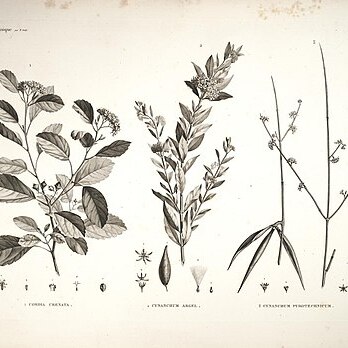Shrub or small tree 1.5–9 m. tall; young shoots with dense adpressed hairs and usually long ± spreading hairs as well, later ± glabrous or long hairs persistent on upper 15 cm. of stem; bark pale buff-brown or grey, often with ± prominent nodular petiole-bases; in subsp. shinyangensis young stems, young leaves, inflorescence-axes and buds ferruginous velvety.. Leaf-blades broadly elliptic, obovate-oblong or almost round, less often oblong-lanceolate, 1–10.8 cm. long, 0.8–8 cm. wide, rounded, emarginate or subacute at apex, or rounded to cuneate at base, entire or frequently crenate to dentate, puberulous to pubescent above and beneath but not or only slightly asperous, or ± glabrous; petiole 0.5–1 cm. long with indumentum like stems when young.. Inflorescences 2.5–3 cm. long, ± sessile to shortly pedunculate; peduncle and secondary axes 0.5–4 cm. long, ± velvety and with long hairs; pedicels 2–3 mm. long.. Male: buds very shortly bluntly acuminate, adpressed pubescent, particularly at the apex; calyx-tube conic-campanulate 3.5–4.5 mm. long; lobes broadly triangular, 1.2–1.5 mm. long; corolla cream or greenish yellow; tube 3.5–4 mm. long; lobes 4–5(–6), ovate-oblong, 4–4.5(–6) mm. long, 1–2.5 mm. wide; filaments 1.5–6 mm. long, rudimentary ovary under 1 mm. long; style absent.. Hermaphrodite: calyx 5.5–6.5 mm. long including 1–1.3 mm. long ovate lobes, ± glabrous outside, minutely pubescent inside; corolla-tube 4–5 mm. long; lobes 4–5(–6), oblong to narrowly ovate, 3–4 mm. long, 1.5–2 mm. wide; filaments 1.5–2 mm. long; style 2–3.5 mm. long; branches very short, up to 1.3 mm. long; stigmatic arms 7 mm. long.. Fruit red, ovoid-globose, 0.7–1.3 cm. long, 6–8 mm. wide, apiculate; calyx cupular, 6.5–9 mm. wide, lobed, glabrous or pilose.
More
A shrub or small tree. It grows 7 m tall. Young plant parts are hairy. The leaves are oval or wedge shaped and 5-8 cm long by 3 cm wide. They are rough above and hairy underneath. Male and female flowers are on separate plants. The fruit are oval and orange and 13 mm long by 8 mm wide. There is one seed.

